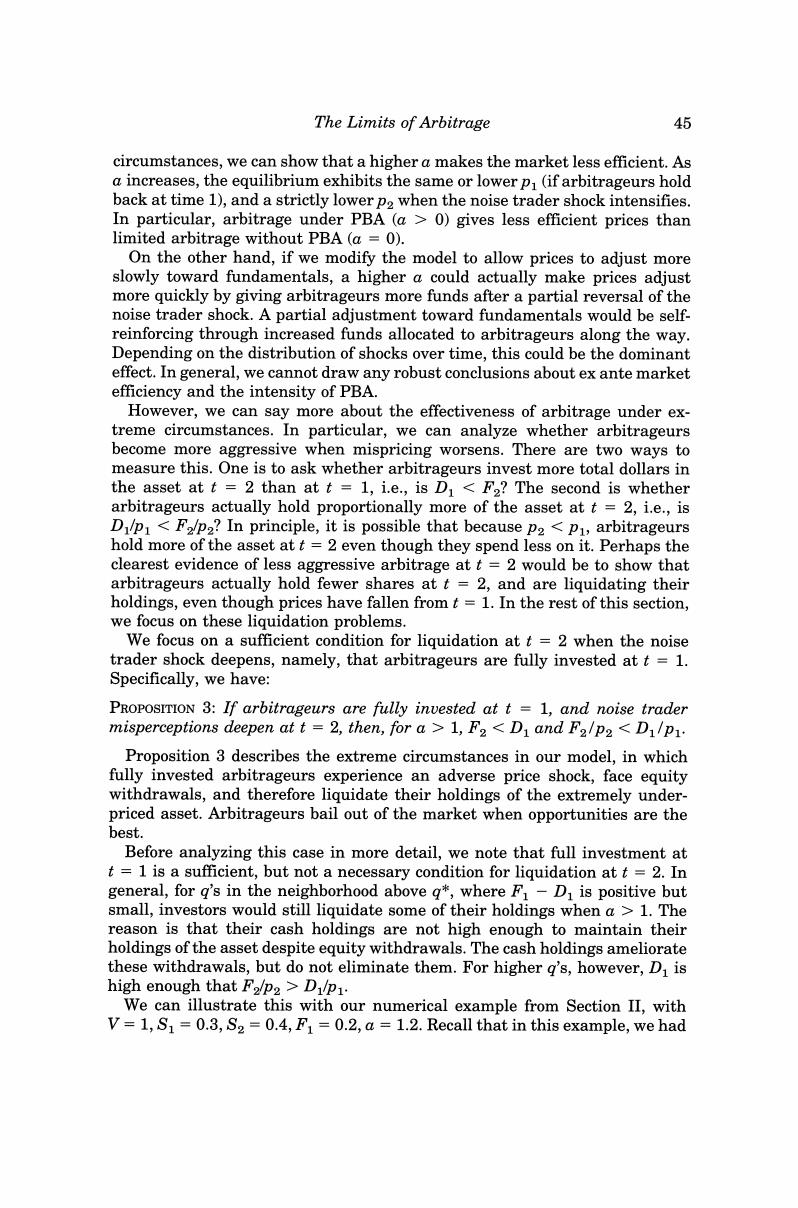正在加载图片...

The Limits of Arbitrage 45 circumstances,we can show that a higher a makes the market less efficient.As a increases,the equilibrium exhibits the same or lower p(if arbitrageurs hold back at time 1),and a strictly lower p2 when the noise trader shock intensifies. In particular,arbitrage under PBA (a>0)gives less efficient prices than limited arbitrage without PBA(a =0). On the other hand,if we modify the model to allow prices to adjust more slowly toward fundamentals,a higher a could actually make prices adjust more quickly by giving arbitrageurs more funds after a partial reversal of the noise trader shock.A partial adjustment toward fundamentals would be self- reinforcing through increased funds allocated to arbitrageurs along the way. Depending on the distribution of shocks over time,this could be the dominant effect.In general,we cannot draw any robust conclusions about ex ante market efficiency and the intensity of PBA. However,we can say more about the effectiveness of arbitrage under ex- treme circumstances.In particular,we can analyze whether arbitrageurs become more aggressive when mispricing worsens.There are two ways to measure this.One is to ask whether arbitrageurs invest more total dollars in the asset at t=2 than at t 1,i.e.,is D<F2?The second is whether arbitrageurs actually hold proportionally more of the asset at t =2,i.e.,is Dp1<F2p2?In principle,it is possible that because p2<pi,arbitrageurs hold more of the asset at t=2 even though they spend less on it.Perhaps the clearest evidence of less aggressive arbitrage at t =2 would be to show that arbitrageurs actually hold fewer shares at t =2,and are liquidating their holdings,even though prices have fallen from t=1.In the rest of this section, we focus on these liquidation problems. We focus on a sufficient condition for liquidation at t=2 when the noise trader shock deepens,namely,that arbitrageurs are fully invested at t 1. Specifically,we have: PRoPOSITIoN 3:If arbitrageurs are fully invested at t =1,and noise trader misperceptions deepen at t=2,then,for a>1,F2<D1 and F2/p2 <D1/p1. Proposition 3 describes the extreme circumstances in our model,in which fully invested arbitrageurs experience an adverse price shock,face equity withdrawals,and therefore liquidate their holdings of the extremely under- priced asset.Arbitrageurs bail out of the market when opportunities are the best. Before analyzing this case in more detail,we note that full investment at t=1 is a sufficient,but not a necessary condition for liquidation at t =2.In general,for g's in the neighborhood above g*,where F-D is positive but small,investors would still liquidate some of their holdings when a>1.The reason is that their cash holdings are not high enough to maintain their holdings of the asset despite equity withdrawals.The cash holdings ameliorate these withdrawals,but do not eliminate them.For higher g's,however,Di is high enough that F2p2>Di/p1. We can illustrate this with our numerical example from Section II,with V=1,S1=0.3,S2=0.4,F1=0.2,a 1.2.Recall that in this example,we had